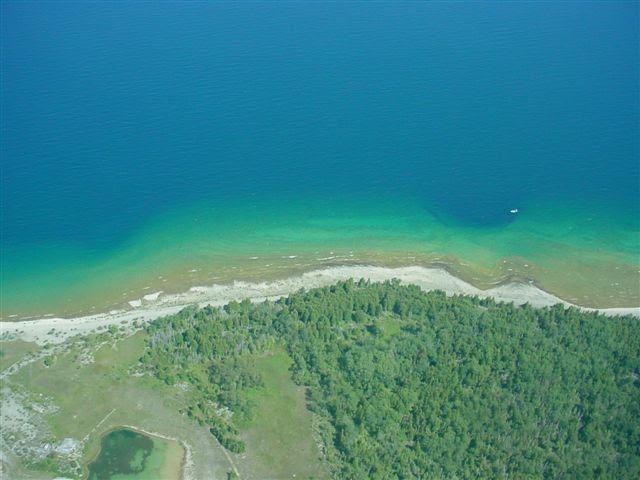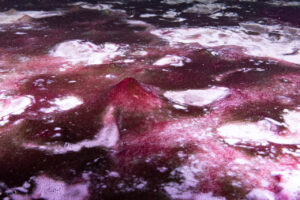
Science Says What? is a monthly column written by Great Lakes now contributor Sharon Oosthoek exploring what science can tell us about what’s happening beneath and above the waves of our beloved Great Lakes and their watershed.
Earlier this year, a group of Michigan scientists published a study in The Journal of Great Lakes Research entitled “Extant mat microbes synchronize vertical migration to a diel tempo.”
Got that?
Yeah, me neither. At least not initially.
But I like to pay attention to science in the Great Lakes so I read on and was delighted to discover it was about Lake Huron’s Middle Island sinkhole.
What’s more, it featured dancing bacteria. It turns out the sinkhole’s bacteria perform daily synchronized movements that might just explain a crucial aspect of Earth’s early history.
I’ve been mildly obsessed with these lake bottom depressions since first writing about them in 2009. Home to brilliant purple mats of cyanobacteria and white floating ponytail-like bacteria, the sinkholes have always struck me otherworldly, almost dreamy.
Initially discovered in Lake Huron, and now in Lake Erie, they are essentially collapsed chambers within the lakebed, formed after dense acidic groundwater seeped under the limestone bedrock. Over time, pressure from the water above caused the weakened bedrock to collapse and form depressions ranging from a few yards to several hundred yards in diameter.
Part of the sinkholes’ otherworldliness is the dense, high sulfur, low oxygen groundwater that feeds them, making their chemistry so at odds with the rest of the lakes that most aquatic life steer clear.
Scientists on the other hand spend a lot of time sending down probes and cameras in hopes of gaining insight into Earth as it was billions of years ago. That’s because the sinkholes’ purple and white bacteria are likely cousins to our planet’s earliest inhabitants — single-celled organisms that formed mat-like colonies carpeting seafloor surfaces.

Colorful underwater microbial mats growing in salty, sulfur-rich, oxygen-poor groundwater clothe the limestone rocks in Middle Island sinkhole. (Photo credit: Phil Hartmeyer, NOAA-Thunder Bay National Marine Sanctuary, Alpena, MI.)
What we owe cyanobacteria
Today we know cyanobacteria as the culprit behind pea soup green, toxic algal blooms fueled by excess nutrient runoff from land. But scientists think cyanobacteria were the first organisms to evolve to capture energy from sunlight and use it to produce organic compounds through photosynthesis — releasing oxygen as a by-product.
Over the course of a couple billion years, these cyanobacteria boosted our atmosphere’s oxygen from next to nothing to nearly 21 percent. In other words, they created a planet capable of supporting life as we know it.
But before these oxygen-producing bacteria got going, life was mostly chemosynthetic — composed of bacteria that use energy in chemical molecules such as hydrogen sulfide to make organic matter for growth in the absence of sunlight. Even today, white chemosynthetic bacterial mats can be found in and around deep-sea sulfur vents. These pigment-free bacteria can also be found in the Middle Island sinkhole, working in concert with the purple photosynthesizing cyanobacteria.
Using an underwater camera to take frequent time lapse photos, aquatic microbial ecologist Bopi Biddanda led a team from Michigan’s Annis Water Resources Institute at Grand Valley State University as it spied on the bacteria in the sinkhole over the course of several days.
It turns out that during the night shift, the white sulfur-oxidizing bacteria cover the purple photosynthesizing bacteria. But at dawn, as sunlight filters into the sinkhole, the white bacteria drop down about three or four millimeters as the purple bacteria move upwards seeking sunlight.
Over the course of the day, the microbial mat turns a deeper shade of purple. But at dusk, as sunlight drains from the sinkhole, it’s the cyanobacteria’s turn to drop down. The white bacteria then rise again, causing the mat to turn from purple to white.
Or as the article puts it, the microbes synchronize their vertical migration to a diel tempo.

Painting an underwater tapestry that is in constant motion, underwater mats in Middle Island sinkhole composed of photosynthetic cyanobacteria (purple) and sulfur-oxidizing microbes (white) alternatively migrate to the surface during day and night to capture sunlight and chemicals, respectively. Modern-day mats like this may have oxygenated our planet in the past. (Photo credit: Phil Hartmeyer, NOAA-Thunder Bay National Marine Sanctuary, Alpena, MI.)
But wait, there’s more
This twice daily color-shifting microbial dance supports a theory put forward in 2021 by a team of international researchers, including Biddanda. If they are right, it would solve an enduring mystery about exactly how cyanobacteria very gradually, and then very suddenly, churned out enough oxygen to transform our planet.
The answer, according to the authors of the Nature Geoscience study, is that increasing day length on the early Earth — the spinning of the young planet slowed over time, making the days longer — probably boosted the amount of oxygen released by photosynthetic cyanobacteria.
Earth’s day length has been slowly increasing since our planet formed about 4.6 billion years ago. This is because the moon’s gravity creates tidal friction, incrementally slowing the planet’s rotation rate.
Still, atmospheric oxygen levels remained below 1% until about 500 million years ago when daylength finally increased to more than 21 hours. After that, the scientists think cyanobacteria went into oxygen turbocharge mode and levels quickly rose, resulting in an explosion of life in the sea and on land.
The team, led by Judith Klatt of the Max Planck Institute for Marine Microbiology and Arjun Chennu of the Leibniz Centre for Tropical Marine Research, came to its conclusion after bringing microbial samples from the Middle Island sink hole to the lab, and then simulating increasing day lengths. Sure enough, oxygen levels rose quickly when they simulated a 21-hour day.
The Journal of Great Lakes Research study got the same results but did it by directly observing the mats in the Middle Island sinkhole over several 24-hour cycles. This is important because lab results do not always translate into the real world.
If they’re right, cyanobacteria like the ones at the bottom of Great Lakes’ sinkholes are unsung heroes: “These dynamic mat worlds, we think constituted all the biosphere there was for maybe three billion years,” says Biddanda. “But they may have laid the crucial groundwork that finally resulted in the oxygenation of the oceans and then the air – one day at a time.”
Catch more news at Great Lakes Now:
Science Says What? Looking for love as northern forests heat up
Science Says What? What’s up with dissolved organic carbon (AKA why is my local stream murky?)
Featured image: This aerial photograph of Middle Island in Lake Huron shows the roughly 20 yard deep and 100 yard wide Middle Island sinkhole. (Photo credit: Bopi Biddanda and Scott Kendall, GVSU)
1 Comment
-
thanks for your enthusiastic comments about the geology of the Great Lakes!




